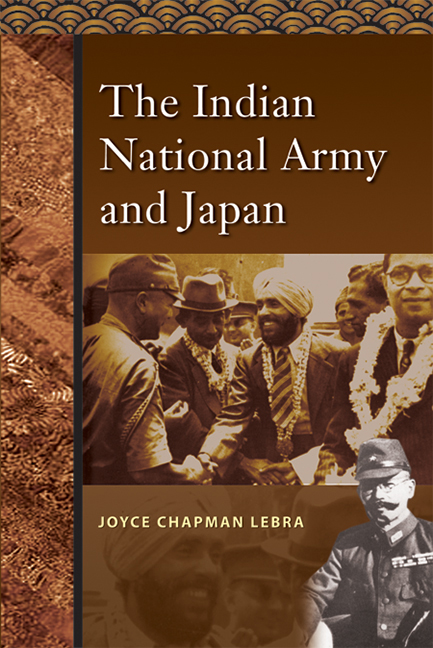Book contents
- Frontmatter
- Contents
- Illustrations and Maps
- Abstract
- Foreword
- Preface
- Acknowledgements
- Introduction
- 1 Mission to Bangkok
- 2 Malayan Jungle Meeting
- 3 Singapore Capitulates and the INA Blossoms
- 4 Tokyo Conference
- 5 Japanese Policy toward India
- 6 The Crisis of the First INA
- 7 Subhas Chandra Bose, Hitler, and Tōjō
- 8 Bose, the FIPG, and the Hikari Kikan
- 9 To India or Not?
- 10 The Rising Sun Unfurls; the Tiger Springs
- 11 A Plane Crash
- 12 A Trial in the Red Fort
- 13 Retrospect
- Notes
- Bibliographical Note
- Bibliography
- Index
- About the Author
- Frontmatter
- Contents
- Illustrations and Maps
- Abstract
- Foreword
- Preface
- Acknowledgements
- Introduction
- 1 Mission to Bangkok
- 2 Malayan Jungle Meeting
- 3 Singapore Capitulates and the INA Blossoms
- 4 Tokyo Conference
- 5 Japanese Policy toward India
- 6 The Crisis of the First INA
- 7 Subhas Chandra Bose, Hitler, and Tōjō
- 8 Bose, the FIPG, and the Hikari Kikan
- 9 To India or Not?
- 10 The Rising Sun Unfurls; the Tiger Springs
- 11 A Plane Crash
- 12 A Trial in the Red Fort
- 13 Retrospect
- Notes
- Bibliographical Note
- Bibliography
- Index
- About the Author
Summary
India was an intriguing problem for Japan on the verge of war in Southeast Asia. The tentacles of the British empire were athwart most of the sea routes in Southeast Asia, and the British-Dutch- American military and economic agreements in the Indies had created a blockade which Japan had to break through to reach vital sources of oil, tin, and rubber. India was, in addition, the stronghold of Britain's power in Southeast Asia. Geography dictated confrontation.
India lay west of the expanding periphery of Japan's wartime Greater East Asia Co-Prosperity Sphere. But nowhere in the most extreme versions of the Co-Prosperity Sphere was there any notion of incorporating hundreds of millions of Indians into the Japanese empire. It would not have been militarily feasible or economically advantageous for Japan to have envisioned a Japanese regime in India. Nevertheless, some Indians in the independence movement feared the Japanese were planning the conquest of India, using the INA to soften the blow to Indian opinion.
Instead, the nationalist aspirations of the Indian independence movement became a natural target for a Japanese propaganda offensive, a logical counter against Britain. Anti-British sentiment in India could be converted into a political and hence military asset for Japan. There was no need for Japan to create an Indian independence movement; she could co-operate with and foster the movement which had existed for nearly a century. This co-operation fitted also into Japan's pattern of a drive against Western imperialism in Southeast Asia.
This possibility occurred to some highly placed Japanese by early 1941 when the portents of war in the Pacific were unmistakable. Diplomatic communiques from Calcutta to Foreign Minister Matsuoka described the Indian independence movement, particularly in Bengal. The attention of the Gaimushō was drawn to Subhas Chandra Bose, Indian revolutionary exile in Berlin, by both Calcutta and the Japanese Embassy in Berlin.
Imperial General Headquarters in Tokyo also took some notice of the independence movement in 1941. The Japanese military attaché in Berlin was instructed to contact Bose and submit a report on him. At nearly the same time, a young major was sent to Bangkok by the Intelligence Bureau of Headquarters on a three-pronged intelligence mission. He would contact and co-operate with Malay groups, overseas Chinese organizations, and Indians organized for the independence struggle. Beyond this IGHQ took no action and made no concrete plans for India.
- Type
- Chapter
- Information
- The Indian National Army and Japan , pp. 210 - 219Publisher: ISEAS–Yusof Ishak InstitutePrint publication year: 2008



